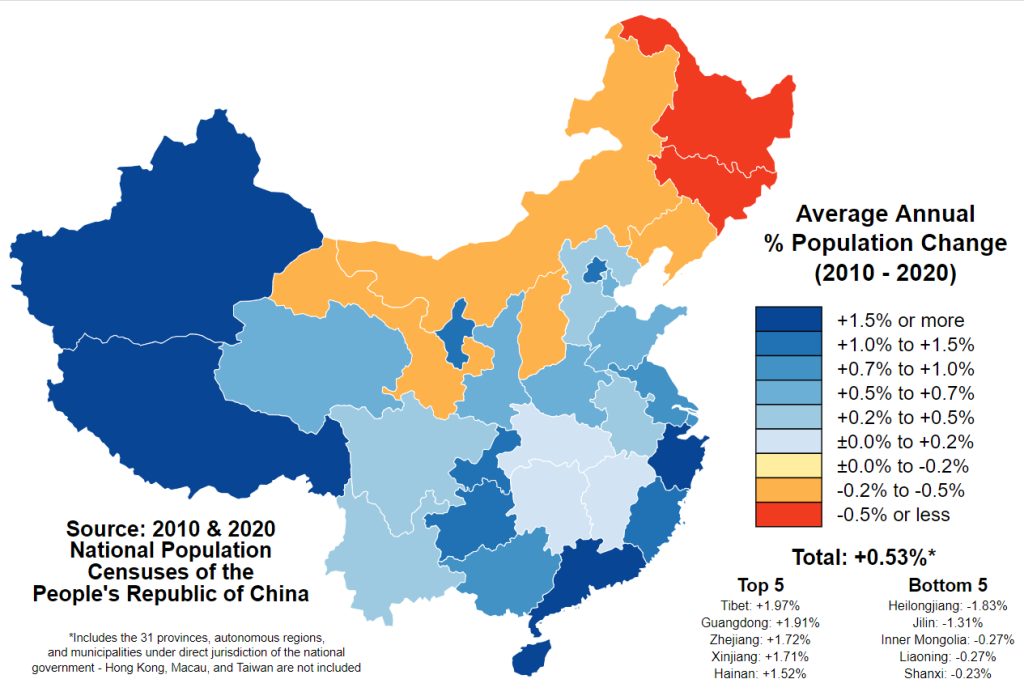With the consequences of its previous family planning policies rapidly approaching, China hopes that its new three-child policy will resolve their rising labor costs, shrinking working class, and aging population.
China implemented its one-child policy in the late ’70s in an attempt to control its enormous population growth. Any couple that broke this policy could be fined, or even in some cases, forced to have an abortion. In 2016, the Chinese government officially changed this policy, allowing families to have two children. But as this change hasn’t led to a sustained population increase, China now faces serious problems with an aging population and an uptick in labor shortages. In an effort to increase its workforce, the country has once again modified its birth policy. As of May 2021, families are allowed to have up to three children.
Responding to its 2020 Census
The announcement came in late May that families in China could have up to three kids. This change was made for the same reasons that motivated their policy change in 2016: declining birth rates. It seems as though the Chinese Communist Party’s strict population laws have proven detrimental to the country’s future.
After receiving the latest population numbers from a comprehensive census conducted at the end of 2020, China immediately implemented the three-child policy.

In a May 31, 2021 report, BBC News explained that the census was conducted by seven million census takers who had gone door-to-door collecting information. According to the BBC, the census “showed that around 12 million babies were born last year – a significant decrease from the 18 million in 2016, and the lowest number of births recorded since the 1960s.”
The Shrinking of A Critical Demographic
A contributing factor to China’s low birth rates is the rapid decline of women in their child-bearing years. Pulling numbers from the National Health Commission of the People’s Republic of China, China Insights reported on their YouTube channel that “the number of women in their prime child-bearing years, between the ages of 20 and 34, in China, is decreasing substantially every year by a total of about 17 million from 2016 to 2020.”
The report attributes this shrinking number of women in this demographic as the “primary cause of China’s current fertility crisis.” It also notes that the low number of abled women today is mainly due to the fact that female babies were forcibly aborted during China’s strict enforcement of the one-child policy — a time where it was more economically advantageous for a family to have a boy.
The Costs of Child Rearing
Another reason why the birth rate has still been consistently low in China despite the two-child policy implemented in 2016 has to do with living expenses. Speaking to this fact, Hao Zhou, a senior economist at Commerzbank, told Reuters on May 31st that “If relaxing the birth policy was effective, the current two-child policy should have proven to be effective too. But who wants to have three kids? Young people could have two kids at most. The fundamental issue is living costs are too high and life pressures are too huge.”
Before this new third-child policy, many citizens couldn’t even afford a second child. As CNN reported in 2019, “More than 50% of families have no intention of having a second child, according to a 2017 study – and the cost is one of the main reasons.”
The implications of these record low birth rates are worrisome for the China’s economic future. “The labor pool is shrinking and the population is graying, threatening the industrial strategy that China has used for decades to emerge from poverty to become an economic powerhouse,” writes Sui-Lee Wee, the New York Times’s China correspondent. The “graying population” she refers to is the country’s large elderly population. Looking at the same 2020 census previously mentioned, Wee says, “People over the age of 65 now account for 13.5 percent of the population, the census showed, up from 8.9 percent in 2010.”
“When it was younger,” she continues, “that population was one of China’s greatest strengths.”
According to Wee, the aging population has led to a shortage of workers, increasing labor costs.
Potentially Ineffective Policy
The 2016 policy change didn’t result in a sustained increase in birth rates, leading many to anticipate that this three-child policy won’t make any significant difference either. “No matter how many babies they open it up to, I’m not going to have any because children are too troublesome and expensive,” says Li Shan, a 26-year-old living in Beijing, during an interview with the New York Times.
In addition to the widespread skepticism over the effectiveness of China’s new three-child policy, some experts believe that until China offers significant incentives for women to bear children, nothing will change. Jean-Pierre Cabestan, a professor of political science at the Baptist University of Hong Kong, told China Insights that “unless the government introduces real incentives, [like] providing special allowances to couples,” their results will continue to be “pretty disappointing.”
Author: Bo John Brusco









